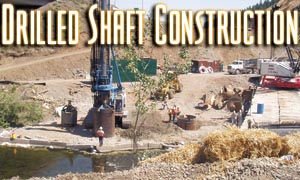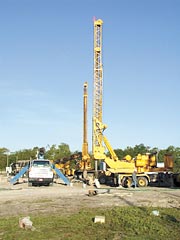
The drilled shaft foundation is employed most frequently either to support heavy loads or minimize settlement, to support uplift loads or to support lateral loads. Because of the versatility of the methods of construction that can be employed, drilled shafts can be properly constructed in a wide variety of soils. Casing or drilling slurry may be used to allow effective construction in soils that are soft or have a tendency to cave or collapse.
The method of construction can be adapted to reduce noise and damage to adjacent structures produced by loss of ground or by soil stress waves that are produced by driving piling. Specialized equipment is capable of excavating under severely restricted headroom.
The high load capacity of drilled shafts may allow the use of a single, large-diameter drilled shaft instead of a group driven piles. Such foundations also can accommodate tight construction areas, such as freeway medians. The size and reinforcing of the drilled shaft is determined by the soil conditions, the loading and the performance requirements. If lateral forces and/or movements have to be resisted, modifications to the structural properties are made to resist the bending stresses. Tensile loads normally are resisted by side friction of the drilled shaft. Reinforcement can be extended directly from the foundation into the structure to mobilize these tensile resistances. Drilled-shaft retaining walls can be used to resist lateral earth pressure as, for example, at a bridge abutment.
Drilled shafts also can be used to assist in stabilizing slopes. In such cases, a detailed study of the slope must be made, and a stability analysis made to investigate the effectiveness of the solution. Other applications of drilled shafts are anchorages for tied-back walls, foundations for waterfront structures, breasting and mooring dolphins, and pier-protection systems. The final decision as to whether drilled shafts are a better solution for a particular problem than another type of foundation must be based on performance requirements, economic considerations and equipment availability.

Advantages of Drilled Shafts
- Construction equipment normally is mobile and construction can proceed rapidly.
- The excavated material and the drilled hole usually can be examined to ascertain whether the soil conditions at a site agree with the expected soil profile. For end-bearing designs, the soil beneath the base can be probed for cavities or weak soil if desirable.
- Changes in geometry of the drilled shaft can be readily made during the progress of a job if the subsurface conditions so dictate. These changes include adjustment in diameter and in penetration and the addition or exclusion of underreams.
- The heave and settlement at the ground surface normally will be very small if proper construction practices are followed.
- The personnel, equipment and materials for construction usually are readily available anywhere in the United States.
- The noise level of the equipment is less than for some other methods of construction, making drilled shafts appropriate for urban construction.
- The drilled shaft is applicable to a wide variety of soil conditions. For example, it is possible to drill through a layer of cobbles and for many feet into sound rock. It also is possible to drill through frozen ground.
- Minimal disturbance is caused to the surrounding soils by the drilling operation; thus, any consolidation settlement due to remolding of the soil will be limited, and reduction of shear strength of clay soils on a slope due to the installation of drilled shafts typically is smaller compared to driven piles, because large pore water pressures are not generated
by drilled shaft construction.
- A single drilled shaft can carry very large loads so that a cap often is not needed.
- Design procedures for axial loading are available that allow designs of drilled shafts to be made considering load transfer both in end bearing and side resistance.
- Special instrumentation and high-capacity loading systems have been developed to allow load tests to be performed to obtain detailed information on the manner in which load is transferred from the drilled shaft to the supporting soil.
- Special techniques are available to allow the non-destructive evaluation of drilled shafts for purposes of quality control and quality assurance.
- The circular shape of the drilled shaft makes it more resistant to the development of local scour around foundations in rivers, streams and estuaries than the non-circular shapes of many other foundations. Elimination of the pile cap - commonly accomplished with drilled shaft foundations - also improves scour resistance.
Some Disadvantages
- The quality and performance of drilled shafts are sensitive to construction procedures, so that both experienced construction personnel and careful inspection are required.
- Drilled shafts normally are not used in situations where the shaft must penetrate an aquifer that is under artesian head (phreatic surface above ground surface).
- The construction of drilled shafts through contaminated soils is problematic because of the expenses incurred in disposing of the soil.
- General knowledge of construction and design methods is lacking in some engineering organizations. Therefore, construction techniques sometimes may be specified that are unsuitable for the stratigraphy at the construction site.
- Since a single drilled shaft frequently is designed to replace a number of driven piles, the redundancy present in the group of driven piles is absent, which, again, requires diligence and expertise in construction and inspection.
While the quality of inspection that is required is not a disadvantage of drilled shafts, an uninformed inspector can create a number of problems during construction. Knowledgeable inspectors and a sufficient inspection staff are of critical importance when difficult drilling or unanticipated soil conditions are encountered. Precise, well-written construction specifications also are extremely important to assure that drilled shafts are constructed in accordance with the assumptions made by the designer and to minimize claims by the contractor.
ND
Report Abusive Comment